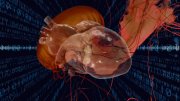IN the march-april 2012 issue, Erin O'Donnell writes about a new tool that shows neurons lighting up as they fire. Watch examples of this work, by Loeb associate professor of the natural sciences Adam Cohen, below.
Fluorescence from an HEK cell expressing Arch. The cell was subjected to steps in voltage from −100 mV to 100 mV at 1 Hz. The apparent voltage-sensitive pixels inside the cell are due to out-of-focus fluorescence from the upper and lower surfaces of the plasma membrane. Images are unmodified raw data. Movie is shown in real time.
Fluorescence from a rat hippocampal neuron expressing Arch, averaged over n = 98 action potentials. Note the delayed rise and fall of the action potential in the small protrusion coming from the process at 7 o'clock relative to the cell body. The time-averaged fluorescence from the cell has been subtracted to highlight the change in fluorescence during an action potential. The background, in gray, shows the time-averaged image.








